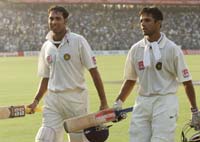|
|
| Help | |
| You are here: Rediff Home » India » Cricket » Special |
|
| |||||||||||||||||||||||
|
| |||||||||||||||||||||||
Of the last 18 Tests played between Australia and India since 1995, only three were drawn, with Australia winning eight and India seven.
 That is probably the closest thing Australia has had to a rivalry in this era of dominance. While other nations have been swept aside with ease, the matches against India resembled intense battles of late.
That is probably the closest thing Australia has had to a rivalry in this era of dominance. While other nations have been swept aside with ease, the matches against India resembled intense battles of late.
Cricket followers keenly await India-Australia Test matches simply because they know India has the firepower to match the men from Down Under on its day. And, fortunately, India has had a lot of good days against the Aussies of late.
Perhaps one of the biggest reasons that helped India compete against Australia at home is the fact that between 1986/87 and 1996/97, the Aussies did not tour India.
It basically meant that a whole generation of Australian cricketers was brought up without any exposure to Indian conditions. It also meant that even the veterans who had played cricket in India had to reacquaint themselves with the conditions every time they came on tour.
Yes, Australia were missing Warne in 1998 and Brett Lee [Images] in 2001, but then this is a team that had prided itself on its bench strength and beaten other countries with less formidable sides.
If one does examine the reasons behind India's success against the Aussies, one of the big factors has to be its batting talent and the way a majority of the players played Shane Warne [Images]. When the leg-spinner was attacked over after over by the Indian batsmen, his aura faded and he was reduced to an ordinary bowler.
Warne, at his best, can be intimidating. Against India, he made no difference.
Tendulkar has an average of 53.11 against Australia; Dravid's is 51.03, Sehwag's is 50.87, Laxman's 52.04 and Ganguly, despite all his recent failures, averages 32.46. There is no team in the world at this point that has four batsmen averaging over 50 against the Australians.
And of the four batsmen, only Sehwag did not play in the 2001 Test series against Australia. The experience of the Indian batsmen counted a lot against the world champions. Added to that India have always had players who could turn the match around quickly. Whether it was the bowlers (Harbhajan Singh [Images], Anil Kumble [Images]) or batsmen (V V S Laxman [Images]) in India, they had the talent and capability to come up with match-winning knocks or bowling performances.
The pitches and the prevalent weather conditions also meant that the cricket wasn't the only thing on the minds of the Australian players. They were also worried about the external factors.
And whatever Ganguly's form may be at the moment, the Indian skipper had then helped the Indian team find its voice. He was brash and arrogant; he wanted to beat the Aussies at their own game and in his own way he made the team believe in itself.
Of late, though, Australia has ensured that its players have had enough experience in India and that has seen them come to terms with India in India.
Ricky Ponting [Images] and his men finally overcame the country that was described as the 'Final Frontier' by Steve Waugh last year.
Now that Australia's has overcome India's challenge as well, one wonders what's next? They will have to hope that the other teams catch up quickly or the stay at the top could be very boring. Won't it?
More Specials
|
|
| © 2008 Rediff.com India Limited. All Rights Reserved. Disclaimer | Feedback |